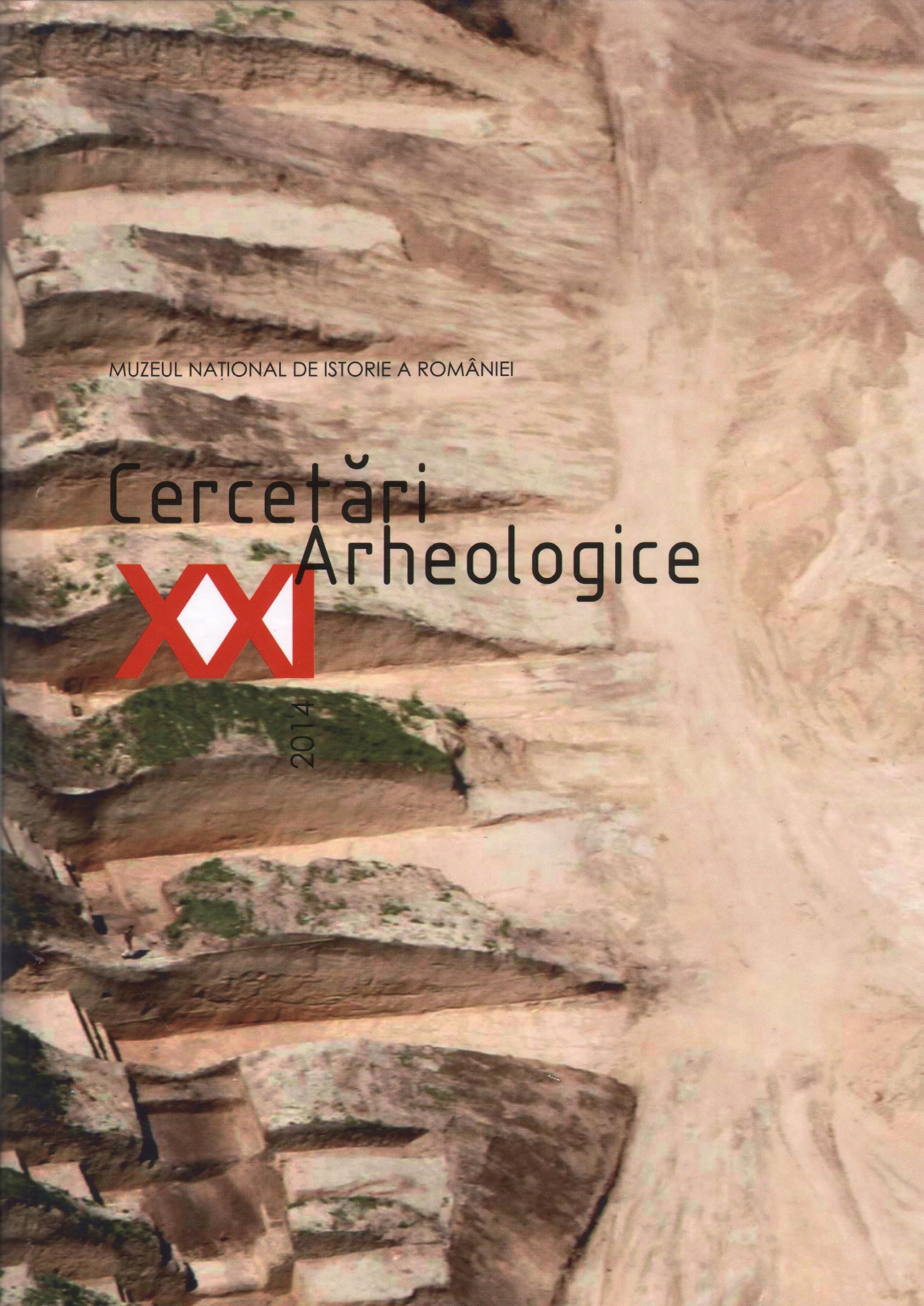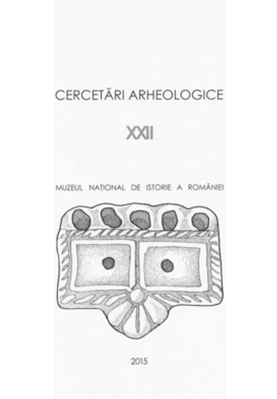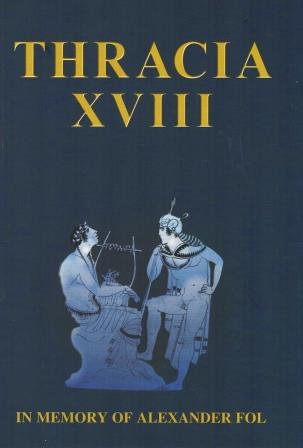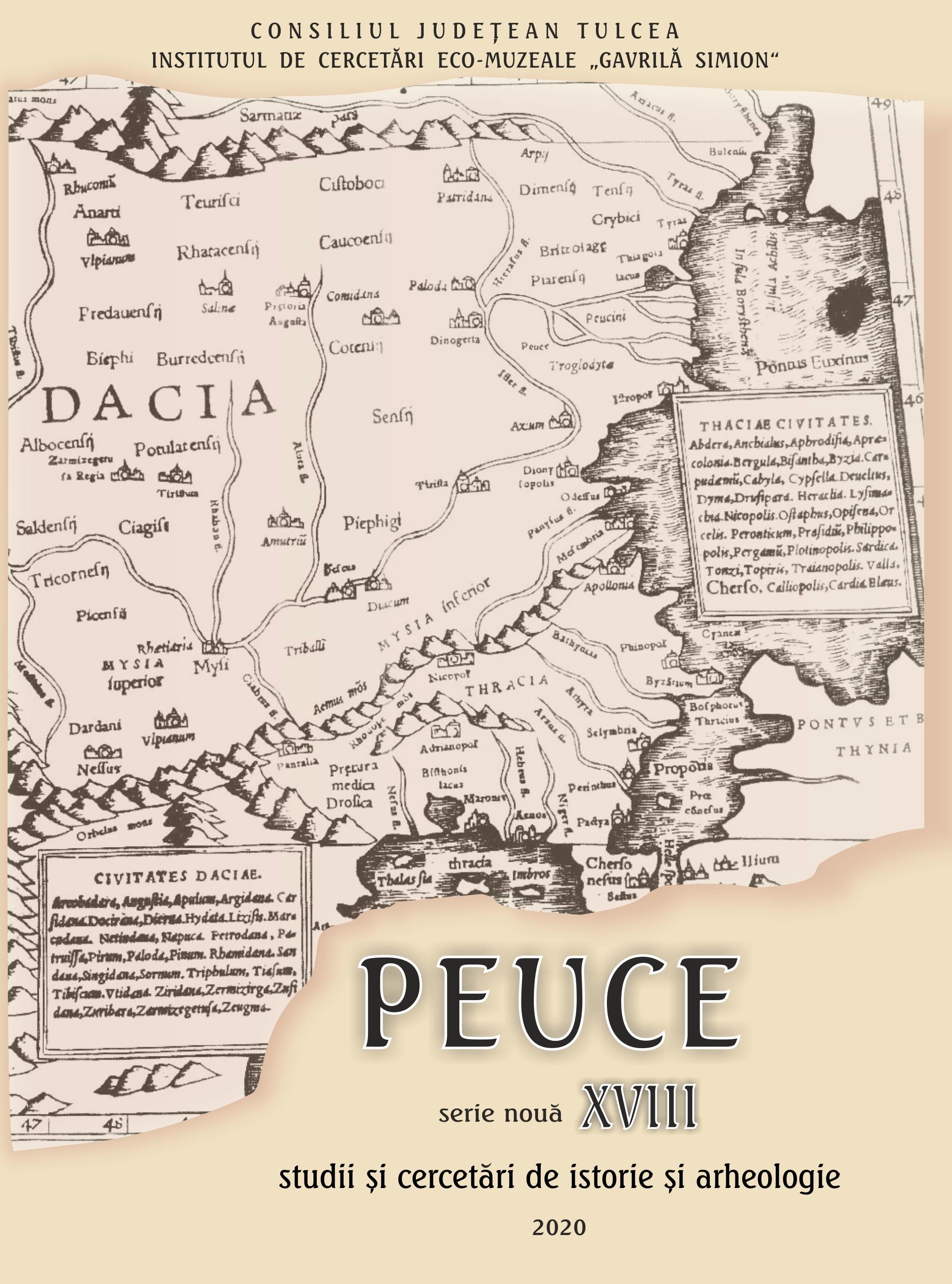



Keywords: disc tiles; convex tiles; tiles with fretwork pattems; panel tiles;
Considering the excavation technique and the shapes, the stove canopy în Wallachia can be categorized as follows: disc tiles, convex tiles, tiles with simple fixing /rame (spangle), fretwork tiles with niche type fixing frame, plate tiles. The pieces have constructive particularities, pertaining to the functionality for which they were made. The decorative repertory of the tiles comprises different motifs: architectural, stylized-anthropomorphic figures, geometric, floral omaments, etc.
More...
Keywords: clay tobacco pipes; Oraşul de Floci; 16th -17th century; tobacco; archaeological contexts;
This article presents sixteen clay pipes discovered at Oraşul de Floci, Giurgeni, Ialomiţa County. They were found in 2008 and 2009, in archaeological contexts dated to the I 6th_ 17th c., along with other elements relevant for chronology: stratigraphy and currency. General criteria for cataloging were established following the smoking pipes from Babadag. Also, there were undertaken further researches in the smoking pipes collections of MNIR and other museums, to highlight specific features.
More...
Keywords: urban establishment; houses; workshop; conservation; 16th – 17th century;
Les rccherches archeologiques de 2008 se sont deroulees sur Ies Grind 3 et 6. Sur le Grind 3 on a continue la rccherchc dans la zone d'oucst (le sccteur de la necropole no. 3) ainsi que dans la zone d'est (le secteur des habitations ayant plusieurs phases de reamenagent des pavements). Sur le Grind 6 on a redecouvert Ies murs de certains edifices identific pendant Ies campagnes anterieures. Cela pour une conservation. protection et la mise en valeur pour Ies visiteurs. De meme, ici, la recherche archeologique a continue par la fouille de 8 sections. On a decouvert du nombreux complexe, entre quel nous insistons sur un atelier de travail des objets en os el sur 4 habitations en bois et clayonnage, avec l'inventaire archeologique tres riche. Les recherches archeologiques de 2009 se sont concentrees sur Ies Grind I et 6. Dans le secteur du Grind 6, on a continue la recherche des complexes identifies dans S. 008/2008 ou a ete decouvert un pavement en terre glaise qui recouvrait une surface de 32 m2 , oriente NE-SO, perfore de nombreuses fosse de poutres, de petites dimensions. Comme suite de l'inventaire archeologique nous somme d'avis qu'il agit d'un complexe ayant un certain role commercial, datant de la fin du xvi< siecle. D'apres Ic projet de recherche, conservation et mise en valeur des monuments decouverts on a fait des ouvragcs de conscrvation pour Ies fondations de l'eglise no. 2, de la maison ayant un fondement de pierres, de ('edifice a contreforts et du pavage d'un atelier ou on obtenait des objets en os.
More...
Keywords: Medieval period; zooarchaeology; mammals; birds; fish;
The fauna examined comes from archaeological complex C5 (pit) dated as belonging to the medieval period in the beginning ofthe XVI 1 " century. We identified several classes ofanimals: fish (6 bones), birds (3), and mammals (371). Zooarchaeology analysis shows that the activity of animal breeding is dominant. The domesticated cattle are the most frequently encountered species, which are followed by the ovicaprines and the pigs. Hunting is poorly represented, only by a single bone which belonged to a wolf. Fish and birds are also present in the diet of the inhabitants which shows the presence of other occupations such as fishing and poultry farming.
More...
Keywords: 16th-17th century dwellings;
Pour diverses raisons, les résultats des dernières recherches archéologiques effectuées sur ce site ont été présentés partiellement. Pendent les années 1998-1999, les recherches ont été poursuivies sur les Grinds no 2, 3 et no 6 – ouest. Sur le Grind no 2, nous avons terminé la recherche de la nécropole no 5, qui sera publiée séparément. Sur le Grind no 6, à l’ouest du fragment de mur de l’église no 1, nous avons fait des investigations sur une zone d’habitations et d’ateliers artisanaux. Nous avons constaté que le plancher de certaines d’entre elles avait été refait 2 ou 3 fois. L’atelier a été détruit par un incendie. Comme suite des modifications dans la composition de l’équipe de recherches, à partir de l’année 2000, les recherches se sont focalisées sur les Grinds no 1 et 3 dans le but de découvrir la disposition des habitations et le système de lotissement des grandes surfaces. Sur le Grind no 1, deux habitations ont été découvertes, composées chacune de deux chambres de superficies inégales. La distance entre ces deux habitations était de 6 mètres. L’habitation no 1 découverte dans la Section I B/2003 constitue une découverte exceptionnelle. A l’extérieur de celle-ci, adossée au mur sud-ouest, une plate-forme de pierre était disposée sur une couche de terre glaise. Cette habitation date du milieu du XVII-ème siècle. Suite à son abandon, deux fours ont été construits sur cette plate-forme, entraînant sa destruction partielle. Pour le moment, nous ne sommes pas fixés sur l’objet d’utilisation de cette plate-forme. En octobre 2003, nous avons été sponsorisés pour réaliser des investigations archéogéophysiques effectuées par le personnel du Laboratoire Mobile de Prospection Archéogéophysique de BCUM - Alba Iulia. L’objectif principal était d’obtenir des informations relatives à l’habitation avec une éventuelle précision des objectifs d’intérêt archéologique sur le Grind no 9 situé dans la partie ouest de la ville. En 2004 et 2005, nous avons effectué deux sections de sondages pour vérifier les dates fournies par l’interprétation de cette investigation. Pour le moment, nous pouvons signaler l’éventuelle existence d’une nécropole. Les recherches sur le Grind no 3 ont mis en évidence trois niveaux d’habitations datés entre la deuxième moitié du XV-ème siècle et le début du XVIII-ème siècle
More...
Keywords: Hallstatt period; Latène period Middle Ages; settlement; research history;
Veröffentlichte Mitteilungen über die Fundstelle „Cetate" von Zimnicea. Die Mitteilungen über die Fundstelle „Cetate" von Zimnicea sind mit einer überraschenden Sparsamkeit in der Fachliteratur, durch zwei kurze Grabungsberichte und mehrere Andeutungen in verschiedenen Beiträgen eingeführt worden, und das trotz den hier durchgeführten 12 Grabungskampagnen: 1924 (I. Andrieşescu), 1948-1949 (I. Nestor) und 1967-1975 (A. D. Alexandrescu). Von den Materialien, die wahrscheinlich bei der Fundstelle „Cetatea" während dieser Grabungen geborgen worden sind, wurden in der Fachliteratur nur unerhofft wenig keramische Stücke systematisch (abgebildet und beschrieben) vorgelegt und das Dank den Einsätze von Vasile Pârvan, Irina Casan-Franga und Dumitru Tudor und nicht der Grabungsleiter der verschiedenen Grabungsteams. Die bislang publizierten Ergebnisse haben gezeigt, dass in der Fundstelle „Cetate" Spuren dreier unterschiedlicher Zeitspannen belegt werden, können und zwar hallstattzeitliche Grabfunde, die von einer sehr intensiven, die fast die ganze Latènezeit andauernden Besiedlung gestört wurden und die ihrerseits von einer mittelalterlichen Dorfsiedlung des 14. – 15. Jahrhundert überlagert war. Gleichzeitig scheint die Stratigraphie der Fundstelle sehr komplex zu sein, in manchen Stellen bis zu einer Tiefe von 4 m. Obwohl die Morphologie des Geländes den Einheimischen aber auch den Archäologen immer die Existenz von Befestigungsanlagen suggeriert hat, wurden in der Fachliteratur niemals Befestigungssysteme erwähnt und das trotz den hier lang andauerten durchgeführten Forschungen. Bezüglich der Unebenheiten im Gelände, die als Verteidigungswall gedeutet wurden, konnte die Forschung bislang ihren anthropischen Charakter nicht belegen. Dagegen konnten Informationen über die Ausdehnung der latènezeitlichen Besiedlung auch jenseits dieser „Schutzgraben" gebracht werden, die alle einfache Graben darstellen, die durch die natürliche (oder auch anthropisch-moderne) Erosion des einheimischen Löss aus dem die hohe, über die Donauaue liegende Terrasse gebildet ist, entstanden sind. Die älteren Forschungen konnten die Kennzeichen jener, leider nicht weiter präzisierten Bauten aus Holz und Steinen, von großen Dimensionen (die I. Nestor von „Türmen" oder „Paläste" zu sprechen bewogen haben) erläutern, deren Reste nur in den Schnitten I und II identifiziert wurden. Nach den Indizien der Fachliteratur (sowohl von Pârvan, als auch von Nestor), wurden für die Errichtung der, innerhalb der latènezeitlichen Siedlung identifizierten Anlagen, Holzbalken, Steine für die Fundamente und eventuell Schilf benützt (Strohlehm wird nicht erwähnt). Manchmal hat A. D. Alexandrescu auch Dachziegel, schon für die erste Hälfte des I. Jahrhunderts v. Chr. erwähnt (was hypothetisch der IV Schicht aus der Siedlung entsprechen würde), doch scheint diese Behauptung mehr fraglich als glaubwürdig zu sein. Die Siedlungsstratigraphie wurde historisiert von A. D. Alexandrescu gedeutet, aber technischer und ausführlicher von Ion Nestor und Radu Vulpe beschrieben. In der von I. Nestor vorgeschlagener Schema, enthält die Stratigraphie der Fundstelle „Cetate" vier Siedlungsschichten, von denen die drei unteren mit Datierungselemente des 4. – 3. Jahrhundert v. Chr.: griechische (attische) Luxuskeramik, gestempelte Amphoren, eine thrakische Fibel und das Bruchstück eines Deckels mit dem Eindruck einer solchen Fibel in der weichen Pasta. Die obere Schicht (Schicht IV) scheint Datierungselemente zu enthalten, die in der aktuellen Forschung als kennzeichnende chronologische Indikatoren für den Ausgang des 2. und der ersten Hälfte des 1. Jahrhunderts a.Chr. betrachten werden. Dazu gehören, unter andern, die einheimischen Nachahmungen der delischmegarischen Becher. Im allgemeinen kann in der Forschung die Dürftigkeit der Argumentation der Synchronisierung zwischen den Siedlungs- und Bestattungsphasen beobachtet werden, doch niemals wurde sie widerlegt: die wenigen, auf der „Cetate" geborgenen und in der Literatur erwähnten Materialien sind aussagekräftig in dieser Richtung. Fragen, die von der älteren Forschung nicht gelöst wurden. Trotz einer anscheinenden Umschreibung auf Grund geomorphologischen Kriterien der latènezeitlichen Siedlung von Zimnicea, muss hervorgehoben werden, dass die Grenzen der latènezeitlichen Besiedlung nicht genügend präzisiert wurden. Aus diesem Blickwinkel sollte sogar die traditionelle Trennung des westlich vom heutigen Zimnicea liegendes Gelände zwischen „Cetate" und „Câmpul Morţilor“ („Feld der Tode“), mit einer gewissen Enthaltung betrachtet werden. Bei der Abwesenheit von publizierten Profilen der erforschten Schnitte fehlt der aktuellen Forschung ein konkludentes und vor allem konkretes Bild der Stratigraphie der getischen Siedlung von Zimnicea; dazu noch erschwert die Unmöglichkeit der Rekonstruktion der stratigraphischen Lage von chronologisch aussagekräftigen Funden, wie z. B. die gestempelten Amphoren, eine eventuelle vertiefte Verarbeitung der gegenwärtigen Quellenlage. Bedeutende chronologische Indikatoren, wie die griechischen Amphoren, aber auch die Becher mit Reliefverzierung können nur hypothetisch mit dem von I. Nestor vorgeschlagenes stratigraphisches Schema in Beziehung gebracht. Beim jetztigen Forschungsstand stehen uns keine konsistente Argumente für eine ununterbrochenen Besiedlung auf der „Cetatea" von Zimnicea vom 4. und bis im 1. Jahrhundert v.Chr. (oder sogar bis im 1. Jahrhundert n.Chr.?) zur Verfügung; im selben Maß können aber auch mögliche Diskontinuitäten nicht argumentiert werden.
More...
Die Schmuck- und Trachtstücke aus dem Gräberfeld von Vadu Anei sind durch Ohrringe mit Kügelchen, mit Räderchen und mit kugekförmigem Anhänger, durch Perlen, einfache Fingerringe, einteilige Fingerringe mit Schild oder Fingerringe mit angelötetem Schild vertreten. Dazu wurden, als Kleidungszubehör, auch kugelförmige Knöpfe behandelt. Die Analyse der 59 Schmuck- und Trachtstücke gestattet ihreZuweisung einer dörflichen Gemeinschaft vom Ausgang des XV, XVI, und auch vom Anfang des XVII Jahrhunderts.
More...
Keywords: Trajan Column; Romanian Academy; Vatican;
Il s’agit d’une interview avec l’ancien ambassadeur de Roumanie à Rome, pendant les années 1966– 1969, concernant histoire de la récupération du moulage de la Colonne de Trajan et de l’Accademia di Romania de Rome par le gouvernement roumain avec l’aide du Vatican. L’interview date du 15 juin 2006.
More...
Keywords: amphora stamps; Heraclea Pontica; Apollonia; Debelt; book review
book review
More...



Keywords: John Terter; Dobrotitza; Bulgarian medieval coinage; Tristria; Silistra
The article declines the possibility that John Terter had a personal coinage in Tristria. All of the examined numismatic and historical arguments reject the possibility that in the mentioned two short chronicles Terter, the son of Dobrotitza, had realized his own coinage in Tristria after 1369, when the town passed into Dobrotitza’s possession. The precedent of self-coinage of a master without a title and without an assigned right to coinage was not realized and is merely a hypothetical mental construction. With that said, the whole hypothesis of “self-governing despot John Terter in Tristria” loses its sole material and documentary basis. The silver coin found in Pacuiul lui Soare is identified as a coin of the Serbian despot John Uglesha and both types of copper coins are identified as coins of despot Dobrotitza.
More...![The Getic Territory of Sboryanovo, Northeast Bulgaria, in the Late Hellenistic Age [2nd Century BC - 1st Century AD]](/api/image/getissuecoverimage?id=picture_2007_55168.jpg)

Keywords: Callatis; coins; monetary circulation; workshop; Dobrudja; Pontus Euxinus; Hellenistic period
The city of Callatis, founded by colonists of Heraclea Pontica, probably in the second half of the 6th century BC, experienced a special period of economic and urban development during the 4th century BC. With its resource-rich agricultural hinterland, the colony sustained a dynamic trade with important commercial centres (Heraclea, Sinope, Thasos, Rhodes etc.). During the second half of the 4th century BC, the local and regional context favoured the opening of a mint that initially struck silver (drachmas, half drachmas and quarter drachmas), then gold (staters) and silver (tetradrachms), as well as bronze coins of various iconographic types. Chronologically, Callatis is the second coin-issuing centre on the west coast of the Dobrudja after Istros. The presence, penetration and possible circulation of monetary issues from Callatis, during the 4th-1st centuries BC, can be traced step by step in different geographic areas, which closely correlate to the directions of trade developed by the colony in different chronological phases. What is noteworthy for the isolated discoveries is, during the fourth century, the widespread distribution of the bronze coins of the city, which are found in overwhelming proportions if we compare them with finds of Greek, Greek-native and native issues (particularly as regards the territory south of the Danube).
More...
Keywords: sociology of translation; socio-cultural reception; socio-political constraints; publishing; Chinese literature; bilateral relations; intercultural understanding; international relations;
According to the sociological theory of literature, constraints on the creation and share of cultural works can be placed between two extremes: one with a high level of politicization and the other with a high level of commercialization (Sapiro, 2003). The overall objective of the present research is to follow the principles of Sociology of Translation to closely map and analyse the publishing activity of Romania concerning China and Chinese literature during the two stages of Romanian Communism – 1948-1965 and 1965-1989. This paper proposes, thus, an extended approach to literature, to its cultural, political and economic reception. In achieving the proposed objectives, the research expands far beyond the literary text itself, to its macro context, analysing, through quantitative research methods, a statistical database created based on two phases - the first part containing literary and non-fictional works that address and discuss issues related to China; the second part includes literary translations of Chinese literature into Romanian, either by direct translation or by an intermediate language. Throughout this paper we will map not only the number of works, but also the topics approached by writers along the two periods of the political life of Romania.
More...
Keywords: Romania;amphorae;stamps;Tomis
The aim of the present article is to publish amphora stamps found during recent archaeological research in Tomis, on the western shore of the Black Sea, focusing this time on stamps found in 2006. The stamps originate from Rhodos, Knidos, Sinope, and Thasos.
More...
Keywords: Romania;Amphorae;amphorae stamps;Callatis;
This article brings additional information to the previous reports on the amphora stamps discovered and published by the authors in various publications in the country and abroad, regarding the new amphora stamps found both in the area of ancient Callatis and its chora.
More...